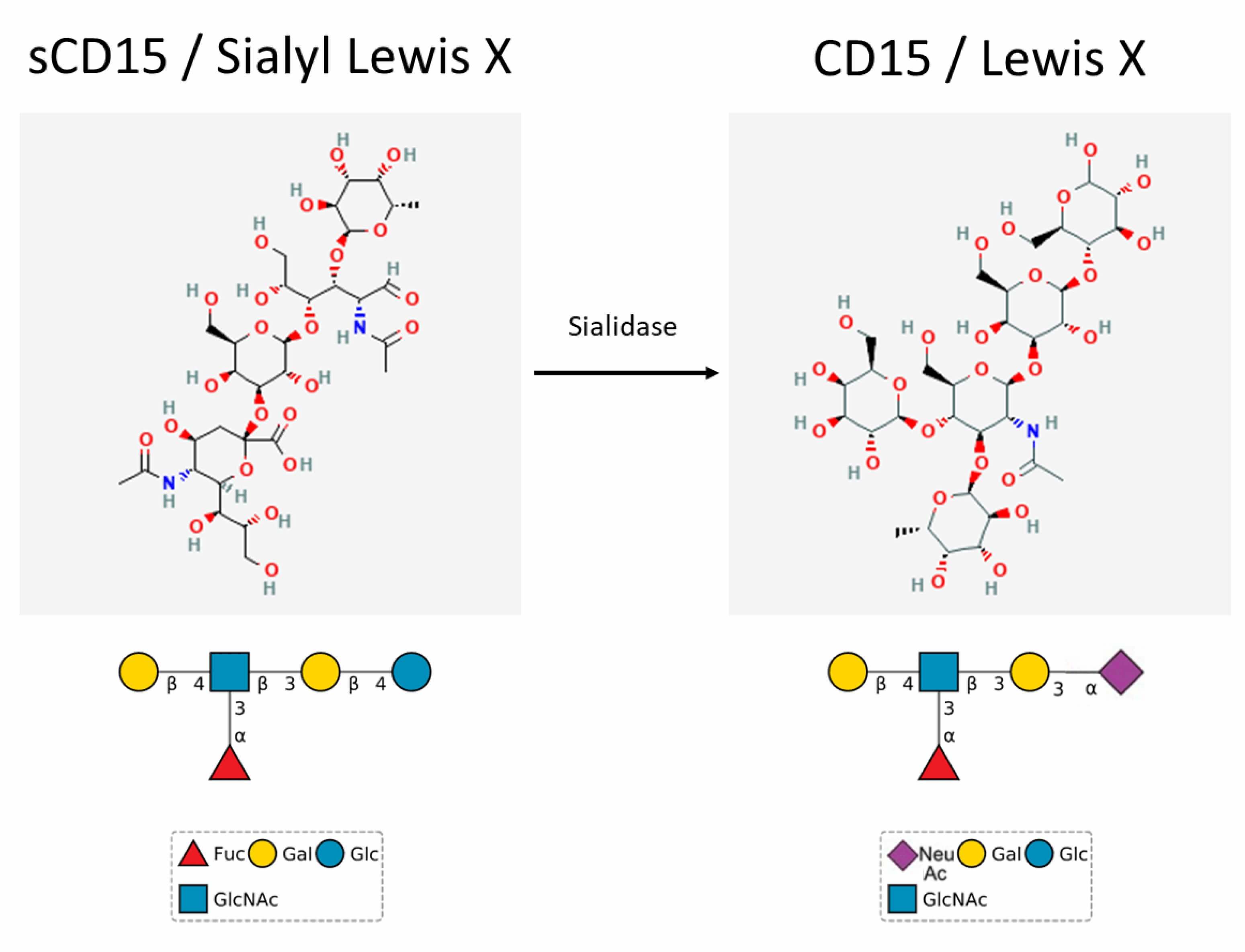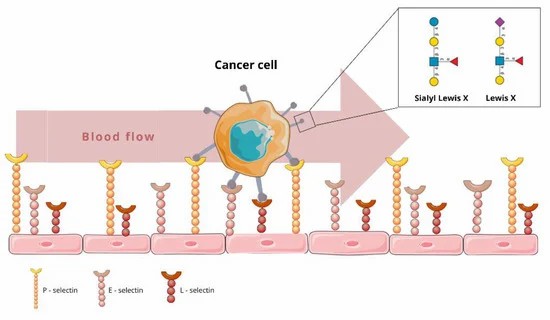Fanolesomab Overview
Introduction of Fanolesomab
Fanolesomab (99mTc-fanolesomab), which is marketed under the name NeutroSpec, is a radiopharmaceutical that is used to visualize infectious diseases. Its specific mechanism of action, by attacking CD15 (Lewis X) on neutrophils, allows it to be used to diagnose a vast range of infections with high sensitivity and specificity. Although its initial applications to appendicitis and osteomyelitis are well-established, it holds immense promise for replacing leukocyte labeling for various infectious conditions. Yet for all its potency, fanolesomab's post-marketing complications and safety concerns suggest continued research and surveillance. Like any medical device, its clinical utility should be carefully considered against risks, and further research is needed to determine its more general potential for other types of infection imaging.
 Figure 1. Structures of CD15 and CD15s, with the enzymatic reaction canalized by sialidase1.
Figure 1. Structures of CD15 and CD15s, with the enzymatic reaction canalized by sialidase1.
What is Fanolesomab's Mechanism of Action?
Fanolesomab is a monoclonal antibody, which is labeled with technetium-99m (99mTc), a radioisotope that enables scintigraphy. The essence of the fanolesomab action is its engagement with the CD15 antigen, a carbohydrate antigen that exists primarily on the surface of neutrophils. The murine IgM class antibody is highly specific for CD15 — much more than most other antigens that radiopharmaceuticals are directed against.
CD15 Binding: How It Works
When given by injection, fanolesomab binds directly to activated neutrophils, a hallmark of inflammation. The neutrophils are sent to body sites of infection, where they assemble and kill the invaders. The adhesion is extremely specific: the antibody binds CD15 on the surface of neutrophils and debris they produce (typical for inflammation or infection).
The major selling point of fanolesomab over the more conventional imaging agents is that it doesn't require in vitro blood transfusion or leukocyte staining. That would mean no more blood harvesting, purification, and radiolabeling that's both time-consuming, messy, and inaccurate.
Mechanisms of Localization in Infected Tissues
Fanolesomab's high neutrophil specificity allows it to be highly localized at the infection site. The two main ways the agent builds up at the infection site are:
- Binding to circulating neutrophils: When injected, the radiolabeled fanolesomab attaches to circulating neutrophils. These neutrophils are then sent to the site of infection or inflammation, a natural immune response to an organism. They are active in neutralizing pathogens when they get to the point of infection.
- Binding to neutrophils and neutrophil debris: During chronic or persistent infections, already-sequestered neutrophils at the infected location (and their debris) still express CD15. Fanolesomab attaches to these neutrophils, even after they are destroyed so that they can image non-aggressive but still active infections.
 Figure 2. Cancer Cell Adhesion to Endothelial Cells by the CD15 Antigen Interacting with E-, L- and P-selectins1.
Figure 2. Cancer Cell Adhesion to Endothelial Cells by the CD15 Antigen Interacting with E-, L- and P-selectins1.
The Clinical Applications of Fanolesomab
Detection of Acute Appendicitis
The most famous clinical application of fanolesomab is for the detection of acute appendicitis, especially when a diagnosis is doubtful. The classic ultrasound and CT scans may not always be accurate, particularly in children or pregnant patients who are at high risk for radiation. 99mTc-fanolesomab, on the other hand, is a non-invasive, radiation-safe option that can be used to distinguish appendicitis from any other stomach condition. In a clinical study of more than 200 patients, fanolesomab was found to be 91% sensitivity and 86% specificity for appendicitis diagnosis. These numbers highlight the promise of fanolesomab as a diagnostic tool for critical situations in which we need to act quickly and accurately.
Osteomyelitis Diagnosis
Fanolesomab also proved very promising in osteomyelitis, especially in diabetic patients with foot ulcers or other issues where osteomyelitis is a common but difficult-to-diagnose condition. In such cases, the agent's affinity for neutrophils in the affected bone tissue facilitates ultra-sensitive imaging for increased diagnostic precision. In one paper, fanolesomab showed 67% specificity and 76% accuracy in the diagnosis of osteomyelitis, which could help to diagnose bone infections missed by standard imaging techniques.
Broader Potential in Infection Imaging
In addition to appendicitis and osteomyelitis, 99mTc-fanolesomab is being investigated for other infections, including infections of prosthetic vascular grafts and diabetic foot infections. Since neutrophils play a key role in the immune response to infection, by using a radiolabeled monoclonal antibody to attack them, we can pinpoint infectious processes, even in the absence of more conventional methods of diagnosis.
What We Provide
Anti-Human CD15 Recombinant Antibody (Fanolesomab)
We provide high-quality fanolesomab for use in IP, IF, FuncS, FC, Neut, ELISA, ICC and most other immunological method. The product is for lab research use only, not for diagnostic, therapeutic, or any in vivo human use.
- Host Species
- Mouse
- Derivation
- Mouse
- Type
- IgG
- Species Reactivity
- Human
- Applications
- Suitable for use in IP, IF, FuncS, FC, Neut, ELISA, ICC and most other immunological methods.
- Trade name
- NeutroSpec
- CAS
- 225239-31-6
- Generic Name
- fanolesomab
- Szlasa, Wojciech, et al. "Prognostic and therapeutic role of CD15 and CD15s in cancer." Cancers 14.9 (2022): 2203. Distributed under Open Access license CC BY 4.0, without modification.
For research use only. Not intended for any clinical use.
This site is protected by reCAPTCHA and the Google Privacy Policy and Terms of Service apply.

